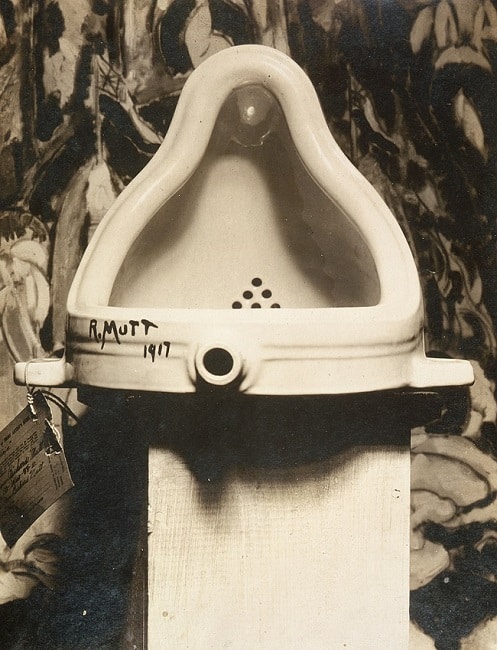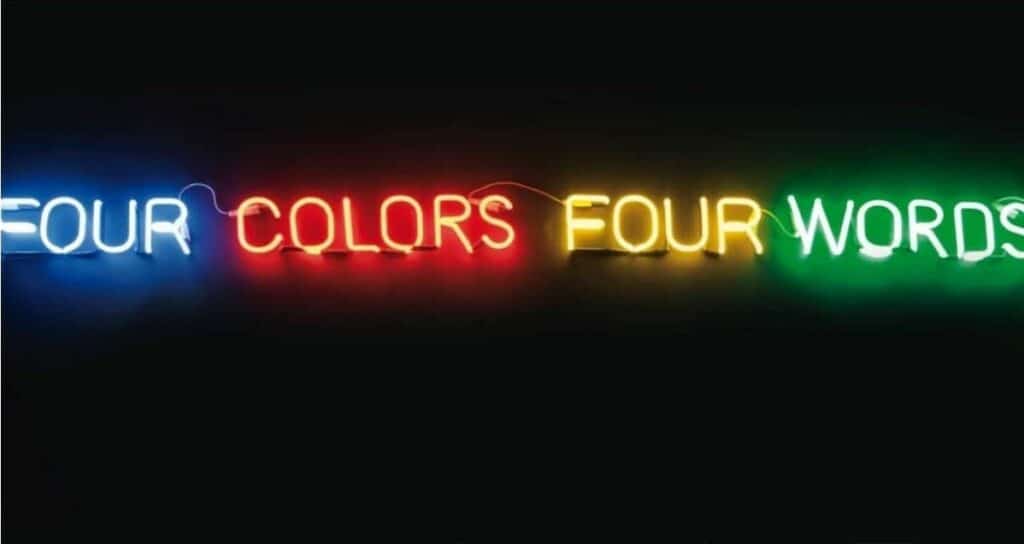The Site as Project Lessons From Land Art and Conceptual Art
Articles and Features
Art Movement: Conceptual Art

"The 'purest' definition of conceptual art would exist that it is an inquiry into the foundations of the concept 'fine art'"
Joseph Kosuth
Conceptual Art definition:
Unpacking the term Conceptual art is not quite as straightforward equally other art movements. It's piece of cake to get confused by the different ways in which the word is used. While it most commonly refers to the art movement between the 1960s and 1970s that emerged in the United States, there are several other ways of understanding it. What exactly does this word connote? When was Conceptualism an art movement, and does it even so be? In his comprehensive bookConceptual Art, art historian Paul Wood distinguishes between the unlike ways the term is used:
one: Conceptualism is often used every bit a negative term for what people dislike about contemporary art which revolves around the concept.
2: Conceptualism refers to the Anglo-American art movement that blossomed in the 1960s and 1970s. The idea, planning and production process of the artwork were seen as more than important than the actual result.
3: A more than expanded notion of Conceptualism holds that men and women in all corners of the world had been working in a conceptual fashion since the 1950s on themes ranging from imperialism to personal identity. In this sense, Conceptualism becomes a Global Conceptualism.
This article will explore both the Anglo-American and the global Conceptual art movement.
What is Conceptual Fine art?
Conceptual art emerged as an art movement in the 1960s, critiquing the previously ruling modernist move and its focus on the artful. The term is usually used to refer to art from the mid-1960s to the mid-1970s. In Conceptualism, the idea or concept behind the work of fine art became more important than the actual technical skill or aesthetic. Conceptual artists used whichever materials and forms were most appropriate to get their ideas across. This resulted in vastly unlike types of artworks that could wait like nigh anything – from performance to writing to everyday objects. The artists explored the possibilities of art-as-idea and fine art-as-knowledge, using linguistic, mathematical, and procedure-oriented dimensions of thought as well as invisible systems, structures and processes for their art.
Key dates: Mid-1960s to mid-1970s
Cardinal regions: Us, Soviet Spousal relationship, Japan, Latin America, Europe
Fundamental words: Concept, idea, language, transitional, political, postmodernist fine art
Key artists: Sol LeWitt, Joseph Kosuth, Mel Bochner, Hanne Darboven, Jan Dibbets, Hans Haacke, On Kawara, Lawrence Weiner, Ian Burn, Mel Ramsen, Yoko Ono, John Baldessari, Art & Language group, Marina Abramović
The origins of Conceptual Art
Although Conceptual art was first divers in the 1960s, its origins trace back to 1917, when Marcel Duchamp famously bought a urinal from a plumber'southward shop and submitted it as a sculpture in an open sculpture exhibition in New York, for which he was on the selection committee. The jury rejected the piece of work, deeming it immoral, and refusing to have it as art. Duchamp'south questioning of where the boundaries of fine art prevarication and his critique of the art establishment paved the way for Conceptual art.

Fluxus
In the early on 1960s, the term 'concept art' was already in utilise by members of the Fluxus movement similar Henry Flynt. Fluxus was a group that embraced artists from Asia, Europe and the Usa. The movement was all about creating an open attitude towards art, far removed from modernism's exclusivity. Fluxus artists were interested in broadening the range of reference of the aesthetic towards anything, from an object to a sound or an activity. Famous Fluxus artists include Yoko Ono, who was active in a wide range of Fluxus activities in both New York and her native Japan, and Joseph Beuys in Germany. Though non alwaysexactly accounted part of the Conceptual art motility, Fluxus is without a doubt 1 of its influences. It was an important trend on the same wavelength every bit Conceptualism, and its artists are frequently regarded as Conceptual artists.
Frank Stella'due south Black Paintings
In the tardily 1950s and early 1960s, Frank Stella created his series of Black Paintings, which marked a crucial point of fracture between Modernism and Counter-Modernist practices. This series of works would lead to the emergence of Minimalist and Conceptual art. The signal of these works was to literally emphasise and echo the shape of the canvas, getting the work off the wall and into three-dimensional space. This was an attack on Modernism that gave ascension to something that was entirely anti-form. The work of art became about actions and ideas, and from this indicate onwards, it seemed similar the floodgates had opened and artists had moved into totally new territory. Modernism had really come to an end.
Sol LeWitt's Paragraphs on Conceptual Art
Sol LeWitt's 1967 article 'Paragraphs on Conceptual Art' inArtforum was one of the near of import writings on Conceptualism. The article presented Conceptual art as the new avant-garde movement. In fact, the term 'Conceptual art' appeared for the first time in this commodity. The opening of LeWitt's article has come to plant the general argument of a Conceptual arroyo: 'In Conceptual art the idea or concept is the most important aspect of the work. When an artist uses a Conceptual form in fine art, it means that all of the planning and decisions are made beforehand and the execution is a perfunctory affair. The thought becomes a machine that makes the art.'
Famous Conceptual Art artists
Joseph Kosuth
Conceptual art equally a articulate movement started emerging in the late-1960s. In 1967, Joseph Kosuth organised the exhibitionsNonanthropomorphic ArtandNormal Artin New York, where works by Kosuth himself and Christine Kozlov were shown. In his notes accompanying the exhibition, Kosuth wrote: 'The actual works of art are the ideas.' In the same year, he exhibited his series ofTitled(Art every bit Idea equally Idea).This serial of works consisted not of visual imagery, merely of words that were at the cadre of the debate surrounding the condition of modern art – 'significant', 'object', 'representation', and 'theory,' among others.

Fine art & Language Grouping
Meanwhile in England, the Art & Linguistic communication Group were investigating the implications of suggesting more and more complex objects every bit works of fine art (examples include a column of air, Oxfordshire and the French Army). The commencement generation of the Art & Language Group was formed by Terry Atkinson, Michael Baldwin, David Bainbridge and Harold Hurrell in 1966-67. Afterward, the group also expanded to the United states of america. In 1972, they produced the Fine art & Linguistic communicationIndex 01for Documenta V. This was an installation consisting of a group of eight filing cabinets containing 87 texts from theFine art-Language journal.
Lucy Lippard'sVi Years
Lucy Lippard'due south bookVi Years, covering the first years of the Conceptual art movement (1966-1972), came out in 1973. In keeping with the confusing and complex nature of Conceptual art, the American artist Mel Bochner condemned her account every bit disruptive and capricious. Years after, Lippard would fence that most accounts of Conceptualism were faulty and that nobody's retentiveness of the actual events related to the development of Conceptual art could be trusted – not even the artists'.
Conceptualism in Europe
Every bit stated earlier, Conceptualism was non merely important in the United states of america and England, but was also widely explored and developed in other parts of the globe, where the work was often far more politicised. In France, around the time of the 1968 student uprisings, Daniel Buren was creating art that was meant to challenge and critique the establishment. His aim was not to describe attention to the paintings themselves but to the expectations created by the art context they were placed in. In Italian republic, Arte Povera emerged in 1967, focused around making art without the restraints of traditional practices and materials.
Conceptualism in Latin America
In Latin America, artists opted for more than direct political responses in their work than Conceptual artists in North America and Western Europe. The Brazilian artist Cildo Meireles reintroduced the readymade with hisInsertions into Ideological Circuitsseries (1969). He would interfere with objects from systems of apportionment like bank notes and Coca-Cola bottles past stamping political messages onto them and returning them into the system similar that.
Conceptualism in Soviet Union
In the Soviet Spousal relationship, art critic Boris Groys labelled a group of Russian artists active in the 1970s the 'Moscow Conceptualists'. They mixed Soviet Socialist Realism with American Pop and Western Conceptualism.
Contemporary Conceptual Art and Conceptualism
Conceptualism in contemporary practice is often referred to as Contemporary Conceptualism. Gimmicky Conceptual artworks often use interdisciplinary approaches and audience participation, and critique institutions, political systems and structures, and hierarchies. Artists who conspicuously use various techniques and strategies associated with Conceptual art include Jenny Holzer and her apply of linguistic communication, Sherrie Levine and her photographic critique of originality, Cindy Sherman and her play with identity, and Barbara Kruger'southward utilise of text and photography.

Equally we've explored the complex and all-encompassing history and presence of Conceptual art, several things come to listen. 1 of its greatest strengths was taking the responsibility to truly investigate the nature of art and institutions. At times, it was an art of resistance to the dominant lodge. At other times, it was a cynical mirror held upwardly to the art world, or a deeply philosophical undertaking. Many artists despised being put in the box of Conceptual fine art, as they despised beingness put into whatsoever box. Yet, nosotros accept attempted to draw certain lines betwixt various artists, events and thought systems that circled around a similar orbit for some time and which can be better understood under the umbrella of Conceptualism.
Conceptual art FAQ
What does conceptual hateful in art?
When an creative person uses a conceptual form of art, information technology means that all of the planning and arrangements are fabricated beforehand, and the execution is a more than a shallow process. In conceptual art, the process behind the piece of work is more important than the finished artwork.
What are the characteristics of Conceptual Art?
Conceptual Art is mainly focused on "ideas and purposes" rather than the "works of art" (paintings, sculptures, and other valuable objects). It is characterised past the utilize of different media and supports, along with a variety of temporary everyday materials and "ready-made objects".
Who is the father of Conceptual Art?
Marcel Duchamp is often known to be the forefather of Conceptual Art. He is best known for his readymade works, like Fountain, the famous urinal that he designated as art in 1917 and that is seen as the first conceptual artwork in art history.
Relevantsources to learn more than
Read more about Art Movements and Styles Throughout History here
Piero Manzoni and his Merda d'Artista: Tin shit be art and who decides?
Learn more about Conceptualism Before, During, and After Conceptual Art by Terry Smith
Learn more than about the Art Term on Tate Publishing
Source: https://magazine.artland.com/conceptual-art/
0 Response to "The Site as Project Lessons From Land Art and Conceptual Art"
Post a Comment